What Are the Common 2016 Toyota Tundra Problems? A Comprehensive Overview

Overview
The 2016 Toyota Tundra presents several common problems, including:
- Transmission issues
- Engine performance concerns
- Braking system defects
- Electrical component failures
While user feedback and statistics suggest that the Tundra is generally reliable, these specific issues can significantly influence owner satisfaction. For prospective buyers, understanding these challenges is crucial. Are you considering purchasing a Tundra? Being aware of these potential drawbacks can help you make an informed decision.
Introduction
Navigating the landscape of full-size pickup trucks can be daunting. The 2016 Toyota Tundra stands out for its reliability, yet it is not without its reported issues. Potential buyers and current owners should be aware of common pitfalls, such as transmission troubles and engine performance concerns, that could impact their driving experience. This article explores these frequently encountered problems, owner feedback, and essential maintenance tips. By understanding these factors, you can make informed decisions and maintain satisfaction with this powerful truck, ensuring that the Tundra remains a dependable companion on the road.
Overview of Common Issues with the 2016 Toyota Tundra
The 2016 Toyota Tundra is widely recognized for its dependability as a full-size truck; however, users have reported several issues. Notably, concerns have arisen regarding:
- Transmission
- Engine performance
- Braking system
- Electrical components
Understanding these challenges is crucial for both prospective buyers and current owners, as they can significantly influence maintenance decisions and overall satisfaction with the vehicle.
Statistics show that while Toyota trucks, including the Tundra, generally require fewer unscheduled repairs than domestic competitors, some owners have still encountered specific problems. For instance, issues with the display screen freezing have been noted, with a prevalence rating of 3 out of 5, which can detract from the overall driving experience. Additionally, it is important to mention that Southeast Toyota Distributors recalled certain model year 2016 Toyota vehicles due to a faulty Load Carrying Capacity Modification Label, which may lead to vehicle overload and increase the risk of a crash.
Owner feedback reveals a blend of satisfaction and frustration. Many appreciate the vehicle’s robust performance and capabilities, yet they also report challenges that can impact their driving experience. A case study on customer satisfaction highlights that the vehicle’s reputation for reliability and low repair frequency contributes to high user satisfaction, despite newer competitors offering more refinement.
Genuine user experiences further illustrate these points. One individual, Steve, expressed satisfaction with his truck, noting that while the factory battery had a short lifespan and the tires could be improved, the vehicle’s overall quality and performance made it a worthwhile investment. He stated, “I’ve had my fair share of experiences with Chevy, Ford, and Dodge trucks… This truck had been on my radar for quite some time… Now nothing is perfect… So far I’m very happy and wished I wouldn’t have waited so long to try the vehicle.” This sentiment reflects a broader trend among truck enthusiasts who value the vehicle’s durability and capability, even when faced with minor issues.
In summary, while the 2016 Toyota Tundra is generally a reliable option, prospective buyers should be aware of the reported problems and consider them when making their purchasing decisions.
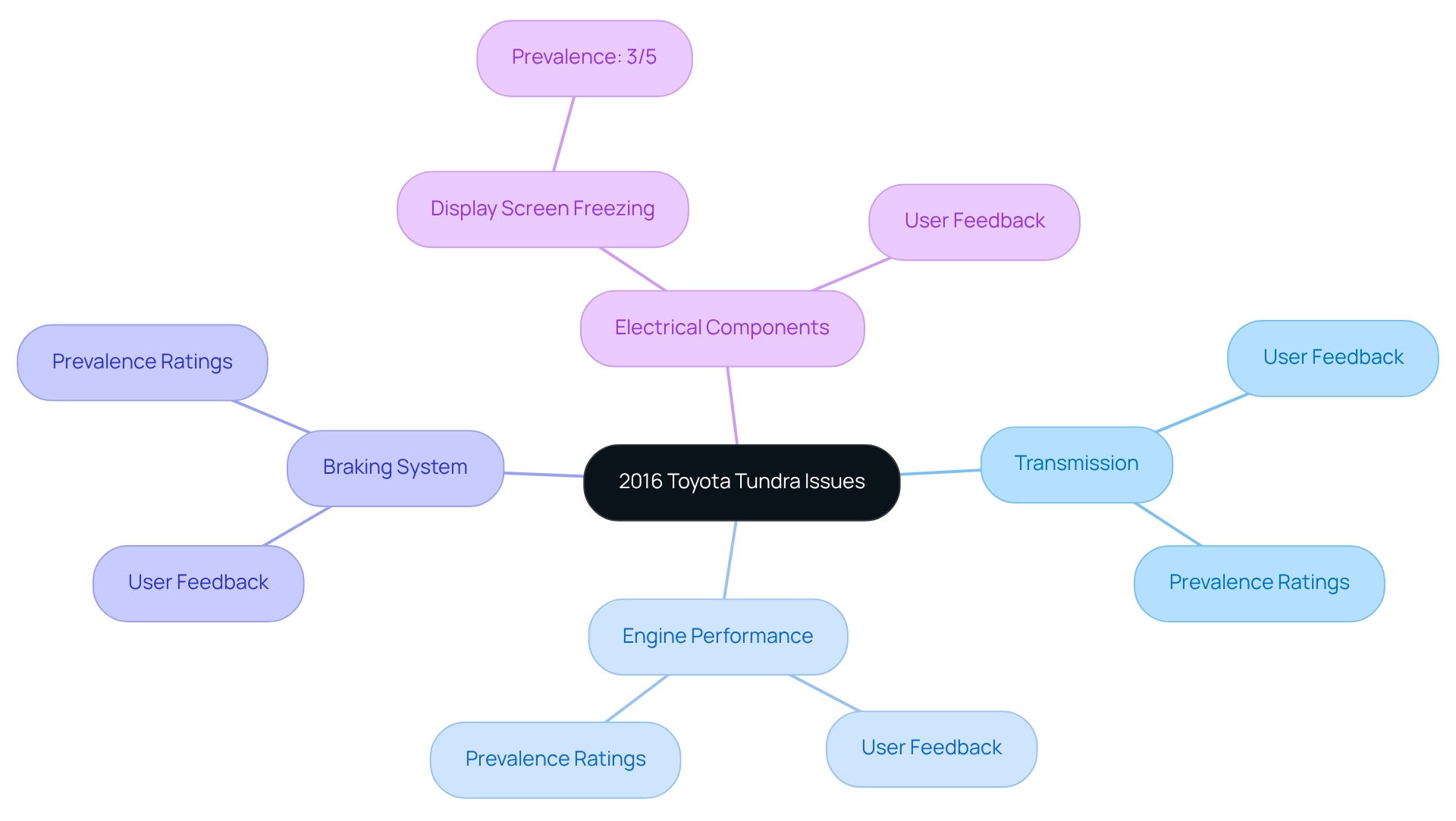
Transmission Problems: Symptoms and Solutions
The transmission issues associated with the 2016 Toyota Tundra have raised significant concerns among owners, particularly regarding symptoms such as slipping gears, delayed engagement, and unusual sounds emanating from the transmission. These problems can arise unexpectedly, often resulting in a frustrating driving experience. Statistics reveal that a considerable number of Tundra owners have reported these transmission-related issues, underscoring the importance of awareness and proactive maintenance.
To address these transmission challenges, several solutions are typically recommended:
- It is crucial to check the transmission fluid levels, as low fluid can lead to performance problems. If the fluid is found to be low, replacing it may resolve minor issues.
- In more severe cases, however, a complete transmission rebuild could be necessary to restore functionality.
- Regular maintenance, which includes fluid changes and inspections, is essential to mitigate these problems and ensure the vehicle remains reliable.
Experts emphasize the need for prompt attention to any warning signs. For example, if drivers experience slipping gears or hear unusual noises, they should seek professional assistance immediately to prevent further damage. Practical solutions shared by vehicle enthusiasts include adhering to a regular service schedule and utilizing premium transmission fluid to enhance performance.
Furthermore, a case study on customer satisfaction with the Toyota model indicates that it has built a reputation for dependability and infrequent repairs. Users express considerable satisfaction regarding its performance and upkeep, reinforcing the importance of promptly addressing transmission issues to maintain the truck’s reputation for reliability. As a single proprietor, M Tron, remarked, “Ultimately, some publications claim other trucks have surpassed this model, but I believe they are still trying to catch up…substantially.”
In summary, while the transmission issues related to the 2016 Toyota Tundra can be concerning, recognizing the symptoms and implementing timely solutions can significantly enhance the driving experience and uphold the truck’s reputation for reliability. Moreover, common issues among drivers of this model, such as a squeaking sound from the glove compartment, highlight the necessity for regular upkeep and attention to detail in car care.
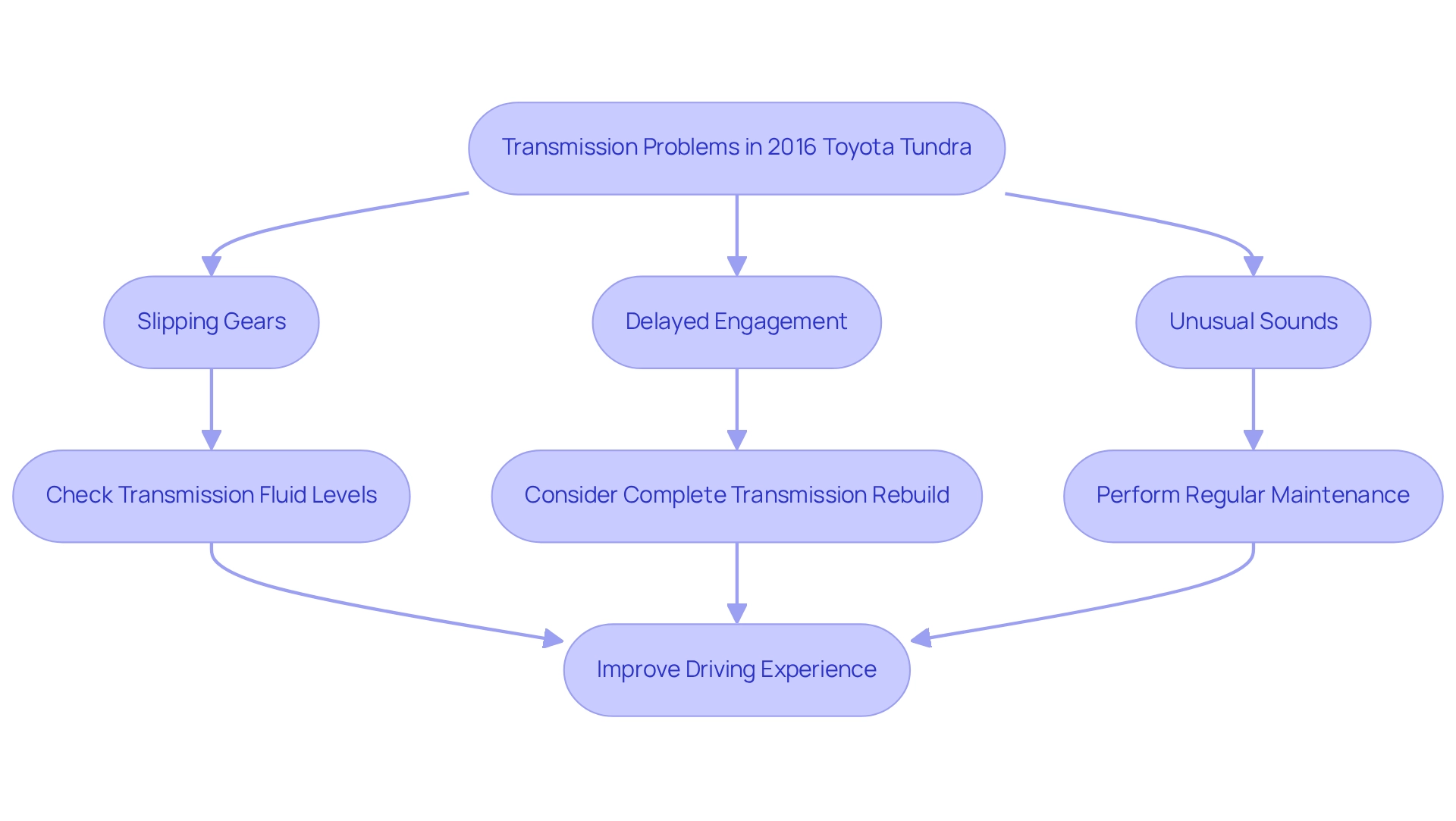
Understanding the Check Engine Light: Causes and Implications
The check engine light in the 2016 Toyota Tundra can illuminate for various reasons, which are among the common problems associated with this model year. These issues may include malfunctions in the oxygen sensor, catalytic converter, or spark plugs. When this warning light activates, it is crucial for vehicle owners to have their car examined promptly. Ignoring this concern can lead to more serious problems and costly repairs. In fact, statistics indicate that a significant number of check engine light incidents are linked to minor issues, such as a faulty gas cap or worn spark plugs, which can often be resolved with simple fixes.
However, more complex problems may necessitate professional intervention. Real owner experiences highlight the importance of addressing the check engine light promptly. For instance, a case study involving 2016 Toyota Tundra problems revealed that the light illuminated due to a malfunctioning electronic control module, among other potential causes. This situation underscores the necessity of regular diagnostics to maintain vehicle performance and prevent further complications.
Professional guidance emphasizes that individuals should not overlook the check engine light. Prompt diagnosis and repair can protect against significant engine damage and ensure the automobile functions safely and effectively. As Jake, an experienced automotive repair technician, notes, ‘Based on your symptoms, it may simply be a wheel speed sensor malfunctioning.’ This statement highlights the necessity for precise diagnostics to determine the root cause of the problem.
Furthermore, the Takata Airbag Safety Recall, which encompasses tens of millions of airbags, serves as a reminder of the vital importance of automotive safety and upkeep. Services provided by Courtesy Toyota of Brandon offer essential assistance for individuals experiencing check engine light problems. Their diagnostic services can help identify the underlying causes, enabling effective repairs and providing peace of mind for vehicle operators.
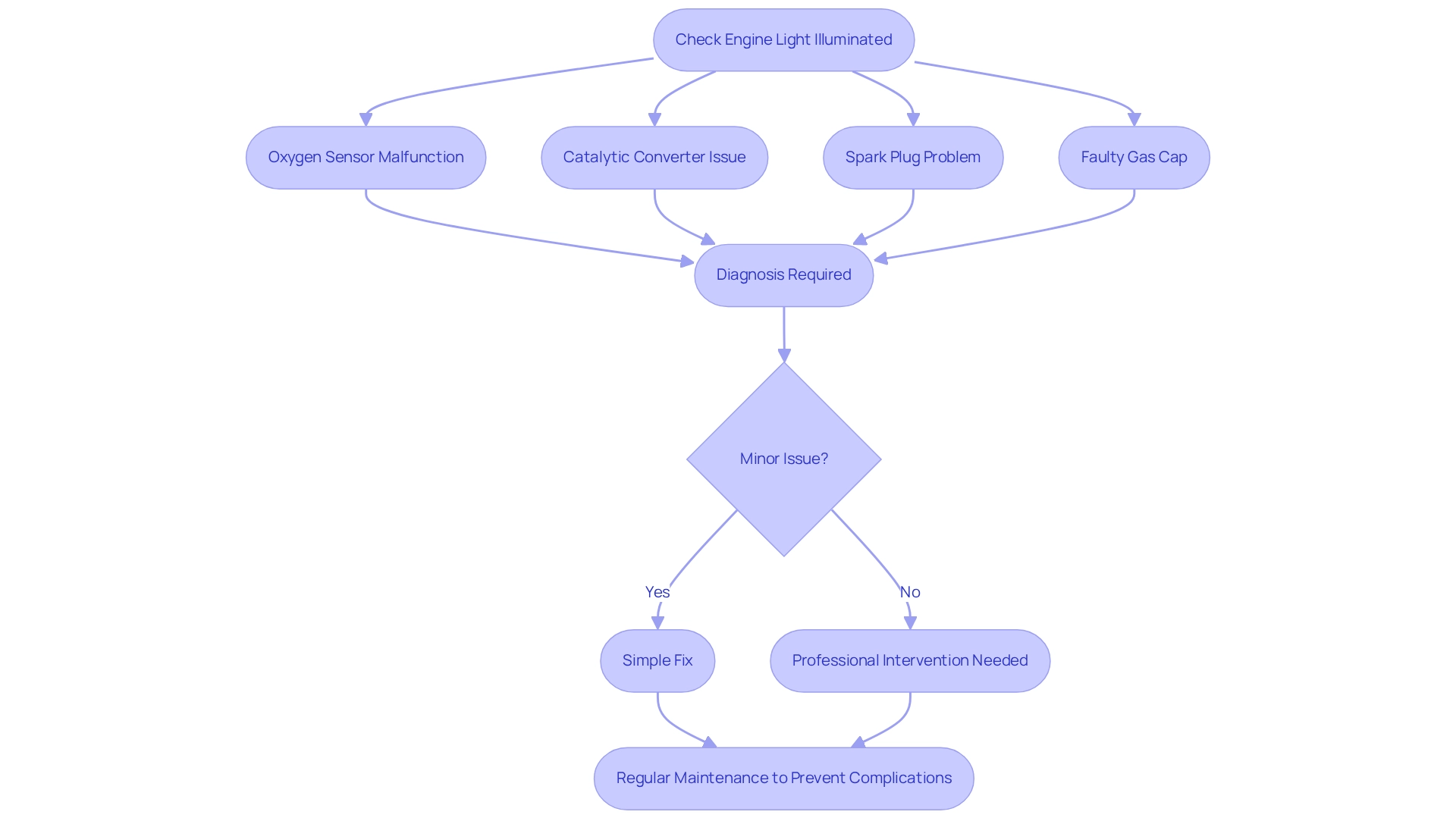
Reliability Ratings and Owner Feedback: What the Data Shows
The reliability ratings for the 2016 Toyota model present a mixed picture. Many sources recognize its strong performance in durability and customer satisfaction. Notably, this vehicle has received commendations for its robust towing capabilities, making it a popular choice for those who require a dependable truck for heavy loads, such as towing a trailer with a cord of wood.
However, several reports have identified specific areas of concern, particularly regarding the transmission and electrical systems. These issues are among the 2016 Toyota Tundra problems emphasized in user feedback. Recent reviews indicate that while the vehicle generally excels in reliability, concerns related to comfort and brake performance have been noted.
According to Consumer Reports, the dependability of the vehicle decreased to average during this period, despite maintaining high customer satisfaction ratings from 2015 to 2020. This suggests that while numerous proprietors appreciate the truck’s overall performance, they should consider the significant mechanical challenges associated with the 2016 Toyota Tundra problems that potential buyers need to take into account.
User feedback often reflects a balance between satisfaction and concern. Some individuals express disappointment over specific mechanical issues, such as squeaking noises from the glove compartment. Additionally, some users have voiced dissatisfaction with the size and fuel efficiency of the 2007 model, which may also be relevant for those contemplating the 2016 version.
A cost assessment of Toyota truck ownership indicates that the overall expense—including components and fuel—could be a significant consideration for purchasers. This is particularly true when contrasted with domestic vehicles that might provide additional features at a more favorable price.
In conclusion, understanding the reliability ratings and consumer feedback for the 2016 Toyota model is crucial for potential buyers. By weighing the advantages and disadvantages, including the truck’s strong performance against its possible mechanical concerns and the overall cost of ownership, consumers can make informed choices that align with their needs and expectations.
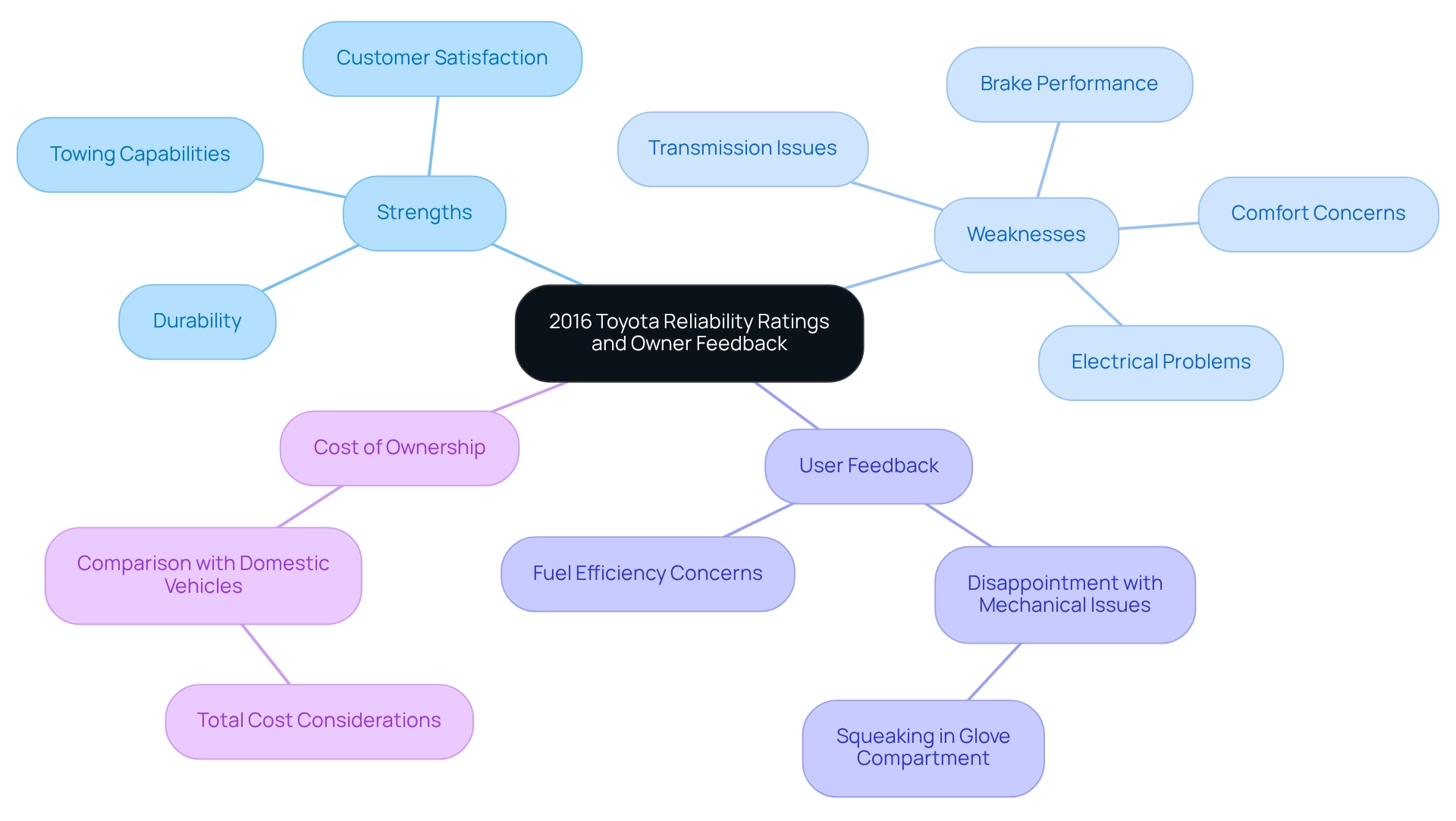
Safety Recalls: What You Need to Know
Owners must take seriously the multiple safety recalls associated with 2016 Toyota Tundra problems. These recalls address essential concerns such as the airbag system and potential fuel leaks, which can pose significant safety hazards. As of April 2025, the National Highway Traffic Safety Administration (NHTSA) has documented several recalls affecting this model, underscoring the importance of staying informed.
A total of 58,729 people are potentially affected by these recalls, highlighting the scale of the issue.
To determine if your Tundra is impacted by any recalls, it is crucial to verify the vehicle identification number (VIN) against the NHTSA database. This straightforward step can reveal whether your truck is subject to any safety recalls, allowing you to take necessary actions promptly. Addressing these recalls not only enhances the safety of your vehicle but also ensures its reliability and performance.
User experiences further emphasize the significance of these recalls. For instance, one owner reported, “Whenever driven a few miles, the rotors warped from overheating,” illustrating the potential consequences of unresolved safety issues. By staying proactive and addressing recalls, Tundra owners can significantly improve their driving experience and peace of mind.
In a broader context, automotive recalls have affected numerous manufacturers, with significant implications reported. For example, Tesla has been involved in multiple recalls impacting millions of cars, demonstrating that safety problems are a widespread issue throughout the automotive sector. Affected car users are often advised to park outdoors and may need to have their vehicles examined for safety enhancements.
In summary, being informed about the 2016 Toyota Tundra problems and the recalls linked to the model, and taking action can lead to a safer and more reliable automobile. Regularly checking for updates and following through on necessary repairs is essential for maintaining the integrity of your truck.
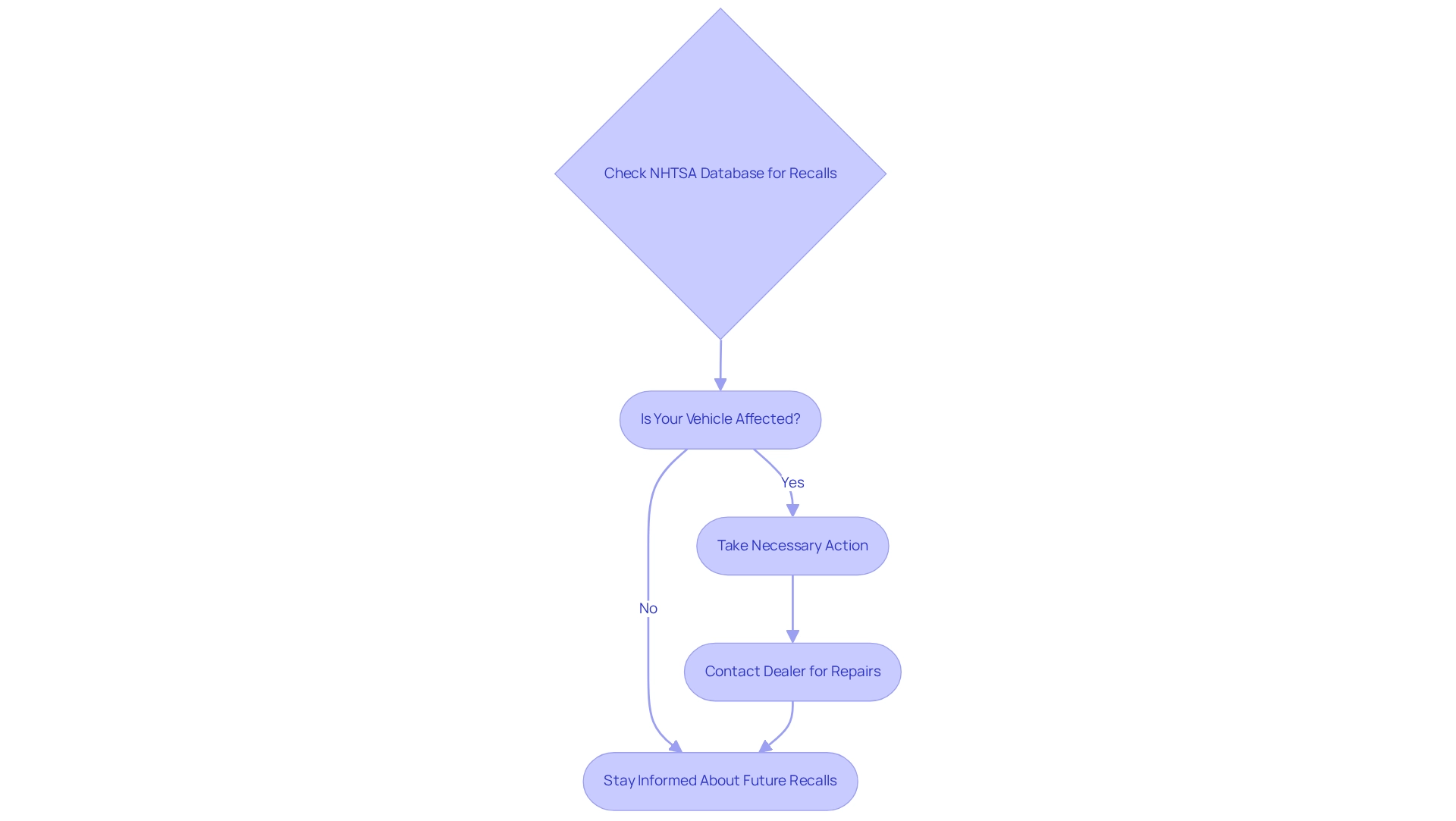
Braking System Concerns: Common Issues and Repairs
Braking system problems represent a significant concern for 2016 Toyota Tundra owners. Frequently reported issues include:
- Soft brake pedals
- Premature brake pad wear
- Vibrations during braking
These challenges not only compromise vehicle performance but also pose serious safety risks, making it imperative for owners to address them promptly. Statistics indicate that a considerable number of vehicle owners have faced these braking issues, underscoring the importance of vigilance.
To alleviate these concerns, regular inspections and maintenance are essential. Owners should prioritize checking brake fluid levels and replacing worn components to ensure optimal braking efficiency. For example, one owner, Rick, shared his experience troubleshooting his Tundra’s braking issues. He adopted a systematic approach, conducting diagnostics and replacing faulty components, which ultimately improved his vehicle’s performance. This case exemplifies the complexities of modern vehicle diagnostics and the value of community advice in overcoming such challenges.
Expert recommendations emphasize the importance of not relying solely on online videos or random opinions when diagnosing braking problems. As Chuck McNiece advises, “Don’t rely on YouTube videos or random opinions. Do the systems scan and look for TSBs. These problems sometimes aren’t component related. I’ve seen wiring damage, corroded connectors, even damage caused by vermin. If in doubt, once you know the trouble codes and can’t seem to identify the problem, a competent dealer is your best option.”
Conducting a thorough systems scan and consulting technical service bulletins (TSBs) can yield valuable insights into potential issues. When trouble codes are ambiguous, seeking assistance from a qualified dealer is advisable, as they can provide guaranteed service and expertise.
Addressing braking system problems promptly not only enhances safety but also contributes to the vehicle’s longevity. By staying informed and proactive, individuals can effectively manage the 2016 Toyota Tundra issues and ensure a safer driving experience. Furthermore, with recent recalls affecting specific vehicles, such as the 2021-2023 ID.4 models due to instrument panel display malfunctions, it is crucial for owners of these models to remain vigilant regarding potential concerns and stay updated on any recalls that may arise.

Engine Problems: Identifying and Addressing Common Failures
Signs of engine issues, such as rough idling, decreased power, and strange sounds, can indicate problems in the 2016 Toyota Tundra. Among the most commonly reported issues are camshaft tower leaks and valve spring failures. These can lead to significant engine complications if not addressed swiftly. Statistics reveal that engine cooling problems, including radiator failures and overheating, are prevalent across various models. Here are five main concerns that Tundra users should recognize regarding 2016 Toyota Tundra problems.
- Rough idling
- Decreased power
- Strange sounds
- Camshaft tower leaks
- Valve spring failures
Detecting these challenges early is crucial to avoid more significant damage and costly repairs. Regular maintenance, including timely oil changes and thorough inspections, plays a critical role in keeping the engine in optimal condition. For instance, one vehicle proprietor reported in January 2023 that after traveling a few miles, they encountered warped rotors due to overheating. This emphasizes the importance of resolving cooling concerns swiftly.
When engine problems arise, it is advisable to consult a qualified mechanic for precise diagnostics and repairs. This ensures the vehicle remains reliable and efficient. Genuine experiences underline the importance of tackling these issues proactively, as ignoring them can lead to more extensive repairs later. A case study on fixing secondary air injection pump failure illustrates that clearing debris from the tubes can resolve check engine light issues. However, if problems persist, replacement may be necessary. By staying informed and observant of the automobile’s performance, individuals can reduce the likelihood of engine failures and enhance the lifespan of their truck.
Top 5.com serves as a trusted source for consumers seeking reliable information, empowering them to make knowledgeable choices regarding their vehicle maintenance.
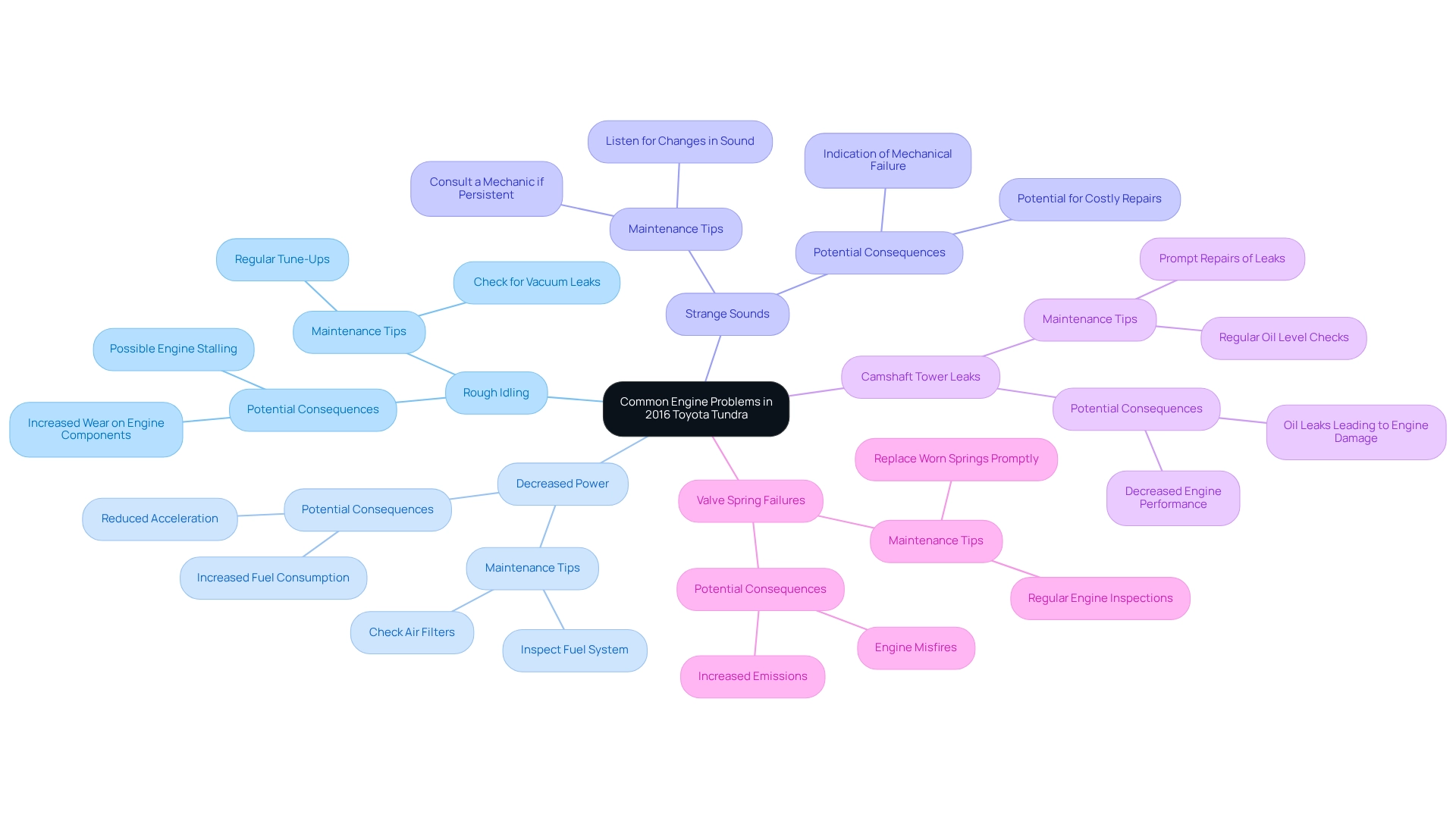
Maintenance Tips: Keeping Your 2016 Toyota Tundra in Top Shape
To maintain the 2016 Toyota Tundra in optimal condition and prevent potential problems, it is crucial for owners to follow a diligent maintenance schedule. This schedule should include:
- Oil changes
- Brake inspections
- Tire rotations every 5,000 miles
Additionally, regularly checking fluid levels and replacing air filters as needed can significantly enhance performance and fuel efficiency.
Addressing minor issues promptly is essential, as this can prevent them from escalating into more significant problems that may lead to higher repair costs.
Expert mechanics recommend that vehicle owners consult the manual for specific maintenance instructions tailored to their model. Engaging with certified mechanics can provide valuable insights into upkeep practices that enhance reliability and safety on the road. Recent statistics indicate that most engines, including this model, require between 5 to 8 quarts of oil, underscoring the importance of regular oil changes.
User experiences further highlight the importance of proactive maintenance. For example, one user, dfarr67, expressed dissatisfaction with a 2007 Tundra’s size and mileage, emphasizing the need for careful consideration when evaluating Tundra ownership. Another individual noted that prompt brake inspections helped prevent costly repairs in the future.
Moreover, case studies suggest that potential buyers of pre-owned Tundras should be cautious about mileage and market prices, as these factors can influence maintenance requirements and overall durability. By following these maintenance tips and leveraging expert advice, Tundra owners can prevent common issues and ensure their vehicles remain in top shape for years to come.
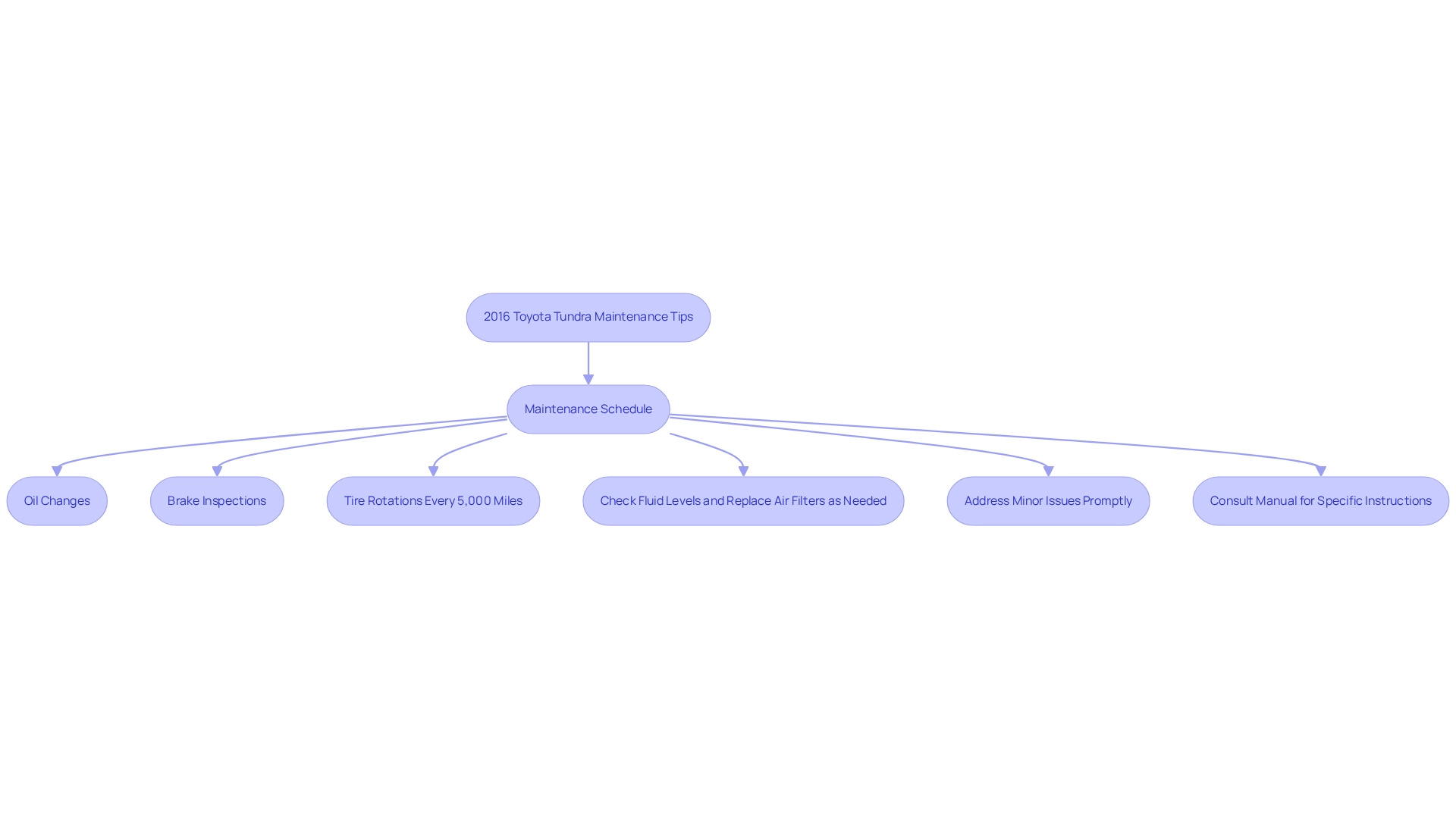
Conclusion
Understanding the 2016 Toyota Tundra is essential for both prospective buyers and current owners, as the truck’s reliability is paired with a few notable concerns. Common issues such as:
- Transmission problems
- Engine performance concerns
- Braking system challenges
can significantly impact the overall driving experience. However, owner feedback often highlights a strong appreciation for the Tundra’s durability and towing capabilities, underscoring its reputation as a dependable full-size pickup.
Addressing these issues proactively through regular maintenance and timely repairs can enhance the Tundra’s performance and longevity. For instance, being vigilant about:
- The check engine light
- Understanding the implications of safety recalls
- Adhering to a comprehensive maintenance schedule
are all critical steps that can lead to a safer and more enjoyable ownership experience. Real owner testimonials further emphasize that while challenges exist, many find the Tundra to be a worthwhile investment.
In summary, the 2016 Toyota Tundra can be a reliable companion on the road, provided that owners remain informed about common issues and take the necessary steps to mitigate them. By balancing the truck’s strengths with an awareness of its potential weaknesses, individuals can make informed decisions that ensure satisfaction and safety in their driving experience.
Frequently Asked Questions
What are the common issues reported by owners of the 2016 Toyota Tundra?
The common issues reported include transmission problems, engine performance concerns, braking system issues, and electrical component malfunctions.
How do the reliability statistics of the 2016 Toyota Tundra compare to domestic competitors?
Statistics indicate that while the Toyota Tundra generally requires fewer unscheduled repairs than domestic competitors, some owners have still encountered specific problems.
What specific transmission issues have been noted by Tundra owners?
Owners have reported symptoms such as slipping gears, delayed engagement, and unusual sounds coming from the transmission.
What solutions are recommended for addressing transmission problems in the 2016 Toyota Tundra?
Recommended solutions include checking and replacing low transmission fluid, performing a complete transmission rebuild if necessary, and adhering to a regular maintenance schedule that includes fluid changes and inspections.
What was the recall related to the 2016 Toyota Tundra?
Southeast Toyota Distributors recalled certain model year 2016 Toyota vehicles due to a faulty Load Carrying Capacity Modification Label, which could lead to vehicle overload and increase the risk of a crash.
How satisfied are owners with the 2016 Toyota Tundra despite the reported issues?
Owner feedback shows a mix of satisfaction and frustration; many appreciate the truck’s robust performance and capabilities, despite facing challenges that can impact their driving experience.
What does owner Steve say about his experience with the 2016 Toyota Tundra?
Steve expressed satisfaction with his truck, noting that while the factory battery had a short lifespan and the tires could be improved, the overall quality and performance made it a worthwhile investment.
Why is it important for prospective buyers to be aware of the reported problems with the 2016 Toyota Tundra?
Understanding these challenges is crucial for prospective buyers as they can significantly influence maintenance decisions and overall satisfaction with the vehicle.





